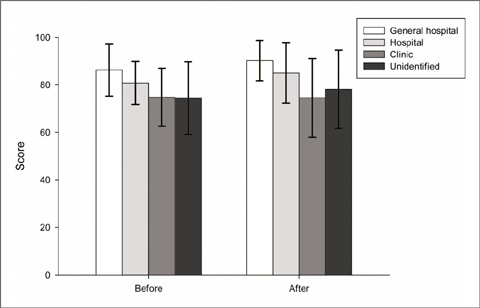Korean J Radiol.
2010 Oct;11(5):553-559. 10.3348/kjr.2010.11.5.553.
Image Quality Improvement after Implementation of a CT Accreditation Program
- Affiliations
-
- 1Department of Radiology, Seoul St. Mary's Hospital, Seoul 137-701, Korea. sejung@catholic.ac.kr
- 2Department of Radiology, St. Vincent Hospital, Gyeonggi-do 442-723, Korea.
- 3Department of Radiology, Uijeongbu St. Mary's Hospital, Gyeonggi-do 480-821, Korea.
- 4Department of Radiology, Bucheon St. Mary's Hospital, Gyeonggi-do 420-717, Korea.
- 5Department of Radiology, Yeouido St. Mary's Hospital, School of Medicine, The Catholic University of Korea, Seoul 150-713, Korea.
- KMID: 1102581
- DOI: http://doi.org/10.3348/kjr.2010.11.5.553
Abstract
OBJECTIVE
The purpose of this study was to evaluate any improvement in the quality of abdominal CTs after the utilization of the nationally based accreditation program.
MATERIALS AND METHODS
Approval was obtained from the Institutional Review Board, and informed consent was waived. We retrospectively analyzed 1,011 outside abdominal CTs, from 2003 to 2007. We evaluated images using a fill-up sheet form of the national accreditation program, and subjectively by grading for the overall CT image quality. CT scans were divided into two categories according to time periods; before and after the implementation of the accreditation program. We compared CT scans between two periods according to parameters pertaining to the evaluation of images. We determined whether there was a correlation between the results of a subjective assessment of the image quality and the evaluation scores of the clinical image.
RESULTS
The following parameters were significantly different after the implementation of the accreditation program: identifying data, display parameters, scan length, spatial and contrast resolution, window width and level, optimal contrast enhancement, slice thickness, and total score. The remaining parameters were not significantly different between scans obtained from the two different periods: scan parameters, film quality, and artifacts.
CONCLUSION
After performing the CT accreditation program, the quality of the outside abdominal CTs show marked improvement, especially for the parameters related to the scanning protocol.
MeSH Terms
Figure
Reference
-
1. CT accreditation program requirement. American Colleges of Radiology (ACR). http://www.acr.org/accreditation/computed/ct_reqs.aspx.2. Korean Institute for Accreditation of Medial Image (KIAMI). http://www.kiami.or.kr/.3. Im TH, Na DG. Annual report No.1 2004~2006. 2007. Seoul: Korean Institute for Accreditation of Medical Image (KIAMI);1–28. 75–105.4. Department of education, KIAMI. The workshop for the examiners of quality assurance program (2006). 2006. Seoul: KIAMI;141–177.5. Park HJ, Jung SE, Lee YJ, Cho WI, Do KH, Kim SH, et al. Review of failed CT phantom image evaluations in 2005 and 2006 by CT accreditation program of the Korean Institute for Accreditation of Medial Image. Korean J Radiol. 2008. 9:354–363.6. Park HJ, Jung SE, Lee YJ, Cho WI, Do KH, Kim SH, et al. The relationship between subjective and objective parameters in CT phantom image evaluation. Korean J Radiol. 2009. 10:490–495.
- Full Text Links
- Actions
-
Cited
- CITED
-
- Close
- Share
- Similar articles
-
- Review of Failed CT Phantom Image Evaluations in 2005 and 2006 by the CT Accreditation Program of the Korean Institute for Accreditation of Medical Image
- Goals and assignments of healthcare accreditation program in Korea
- Understanding of the new Korea Healthcare Accreditation System
- Improvements during the second cycle healthcare accreditation program in Korea: Toward the global standard for patient safety and quality of healthcare
- The Current Status and Necessity of Metabolic and Bariatric Surgery Accreditation System in Foreign Country


